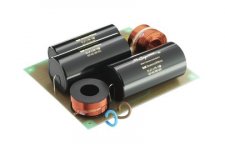It is a first order electrical and there is a service manual on bwgroupsupport. Ideal candidate for a crossover tweek.
It seems to be 1.4mH bass coil to a 6" woven and coated Kevlar driver with a phase plug in a reflex box. 4,7uF and 0.5R optional level adjust to a 4 ohm tweeter. Positive polarity.
Look in B&W CM5 service manual here: B&W Group North America Service & Support - Home
It seems to get a pretty good review: Bowers & Wilkins CM5 loudspeaker Measurements | Stereophile.com
You've got to admire B&W's superb and open documentation. I'm not sure that picture that m'learned friend Galu posted looks quite right. The service manual is quite clear we are looking at first order electrical.
I have heard some of B&W designs of this type. Low order filters and tidy drivers sound very good and lively with jazz and acoustic music, but possibly get muddled or harsh with complex structures like classical music.
Good candidates for diy easy builds include SEAS woven 6" polycone H1571-08 U18RNX/P
And this Peerless 830874 6" polycone : Peerless 830874 HDS 164 PPB MidWoofer Speaker
Of course the SB Acoustics 6" Satori: 61/2" SATORI MW16P-8 :: SB Acoustics
Joachim Gerhard like this SEAS DXT tweeter on first order, say, 3.3uF: http://www.seas.no/index.php?option=com_content&view=article&id=99:h1499-06-27tbcdgb-dxt&catid=45:seas-prestige-tweeters&Itemid=462
I think we get the picture. Me, I'd build a three way, but some fun to be had with the refined two way idea. 🙂
Look in B&W CM5 service manual here: B&W Group North America Service & Support - Home
It seems to get a pretty good review: Bowers & Wilkins CM5 loudspeaker Measurements | Stereophile.com
You've got to admire B&W's superb and open documentation. I'm not sure that picture that m'learned friend Galu posted looks quite right. The service manual is quite clear we are looking at first order electrical.
I have heard some of B&W designs of this type. Low order filters and tidy drivers sound very good and lively with jazz and acoustic music, but possibly get muddled or harsh with complex structures like classical music.
Good candidates for diy easy builds include SEAS woven 6" polycone H1571-08 U18RNX/P
And this Peerless 830874 6" polycone : Peerless 830874 HDS 164 PPB MidWoofer Speaker
Of course the SB Acoustics 6" Satori: 61/2" SATORI MW16P-8 :: SB Acoustics
Joachim Gerhard like this SEAS DXT tweeter on first order, say, 3.3uF: http://www.seas.no/index.php?option=com_content&view=article&id=99:h1499-06-27tbcdgb-dxt&catid=45:seas-prestige-tweeters&Itemid=462
I think we get the picture. Me, I'd build a three way, but some fun to be had with the refined two way idea. 🙂
That's correct Steve! The picture I attached was purported to be a CM5S2 (i.e. CM5 Series 2) crossover - not a CM5 crossover. 🙂I'm not sure that picture that m'learned friend Galu posted looks quite right.
B&W CM5
Thanks everyone for your help. The tweeter conked out on one side, but the tweeter itself is okay; so perhaps it's just a matter of replacing one capacitor.
Thanks everyone for your help. The tweeter conked out on one side, but the tweeter itself is okay; so perhaps it's just a matter of replacing one capacitor.
I'd be surprised if a Mundorf 4.7uF capacitor has failed. Much more likely a break in the wiring or soldering.
To test a tweeter, just connect a 1.5V AAA battery across the tweeter terminals and listen for a scratchy sound. Tells you there is life in it.
Then examine all the connections.
This is a biwire crossover, so you can work with the top HF connection from the amp. Nothing will break. BTW, you usually need a wired link between HF and LF with single speaker leads. Just how biwire works.
To test a tweeter, just connect a 1.5V AAA battery across the tweeter terminals and listen for a scratchy sound. Tells you there is life in it.
Then examine all the connections.
This is a biwire crossover, so you can work with the top HF connection from the amp. Nothing will break. BTW, you usually need a wired link between HF and LF with single speaker leads. Just how biwire works.
Last edited:
- Status
- Not open for further replies.
- Home
- Loudspeakers
- Multi-Way
- B&W CM5 Crossover
